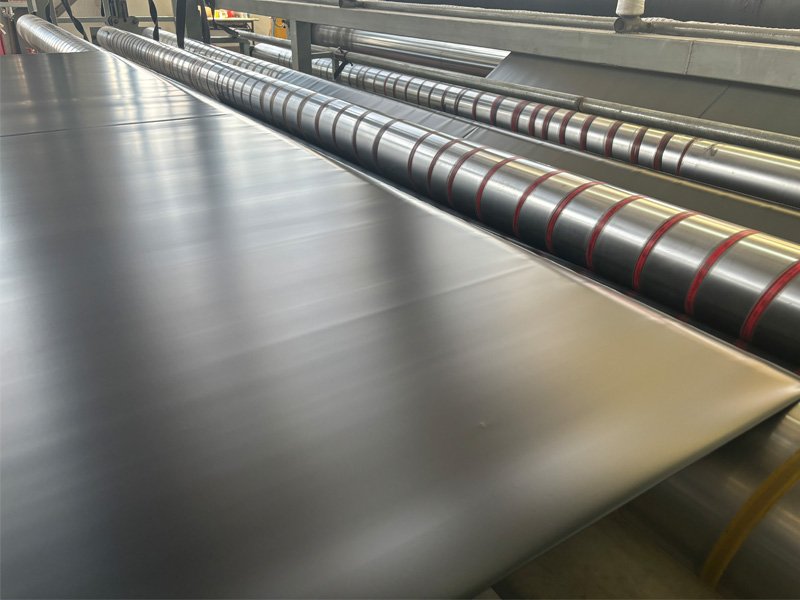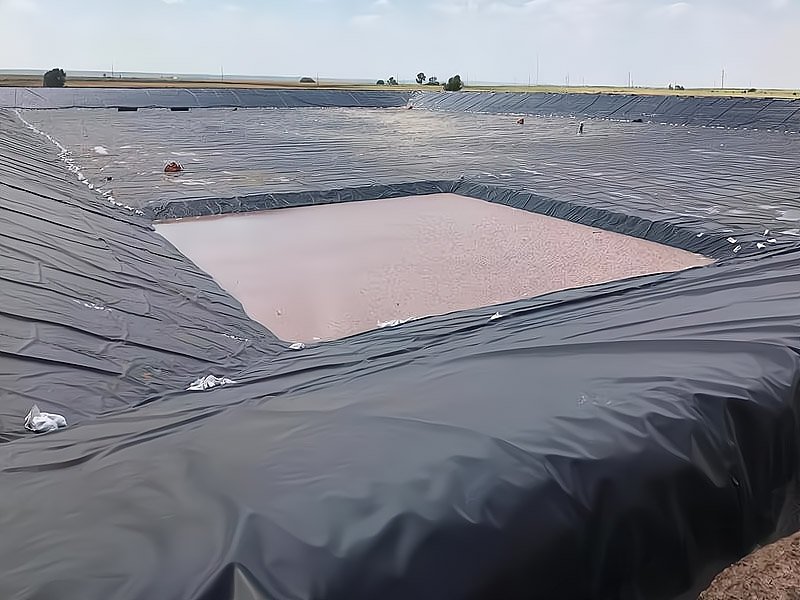HDPE Tank Liner as know as HDPE Geomembrane Liners are a great solution when you need UV and Ozone resistance for your tank, as well as chemical resistance. While HDPE geomembrane liners are typically used in landfills and wastewater treatment plants, they are also used as tank liners.As a leading geosynthetics manufacturer, GEOSINCERE has been providing high-quality geotechnical products to customers all over the world, adhering to the principle of high quality and high service to ensure that customers buy satisfactory products.
1. What Is HDPE Tank Liner?
High-density polyethylene (HDPE) tank liners serve as protective barriers, shielding the interior of tanks from corrosion and damage. Known for its strength, durability, and chemical resistance, HDPE forms an effective barrier between the tank’s contents and structure, thereby preventing contamination and prolonging the tank’s lifespan.
These liners find widespread use in water storage tanks, chemical storage vessels, and wastewater treatment facilities. They come in a range of sizes and thicknesses to accommodate diverse applications and can be tailored to fit specific tank dimensions upon request. The installation process involves placing the liner within the tank and securing it with bolts, clamps, or alternative fastening mechanisms.
To ensure optimal performance, HDPE tank liners require routine maintenance. This includes regular inspections to identify any signs of wear and tear, along with cleaning to prevent the accumulation of deposits that could compromise the liner’s integrity over time.


2. What Are Characteristics Of HDPE Tank Liner?
2.1 HDPE Tank Liner – Chemical Resistance
HDPE Tank Liners exhibit exceptional resistance to a broad spectrum of chemicals, encompassing acids, alkalis, and organic solvents. This remarkable resilience positions them as the ideal solution for scenarios where the containment of hazardous substances or the safeguarding of soil and groundwater is paramount. Specifically, they are indispensable in landfills, industrial storage facilities, and mining operations, where their chemical imperviousness ensures both environmental protection and operational safety.
Moreover, this inherent resistance not only underscores their reliability in preventing contamination but also highlights their versatility across various demanding industries. Consequently, HDPE Tank Liners have become the go-to choice for professionals seeking durable and effective containment solutions that prioritize environmental stewardship and compliance with stringent regulatory standards.
2.2 HDPE Tank Liner – Impermeability
HDPE Tank Liners demonstrate superior impermeability, actively preventing the passage of gases, liquids, and solids. This critical feature is vital for water containment applications, including ponds, reservoirs, canals, and wastewater treatment facilities. Moreover, their effectiveness in these settings underscores their importance in environmental management and protection.
2.3 HDPE Tank Liner – Durability
HDPE Tank Liners boast remarkable durability and longevity, standing up to the test of time with their resistance to punctures, tears, and degrading UV radiation. This unwavering durability guarantees dependable performance over extensive periods, even when exposed to the most challenging environmental conditions.
2.4 HDPE Tank Liner – Flexibility
HDPE Tank Liners, renowned for their durability, also exhibit remarkable flexibility. This adaptability enables them to conform seamlessly to irregular subgrades and undulating terrains. Consequently, installation becomes a straightforward process, as the liners can effortlessly adjust to diverse site conditions. This inherent flexibility significantly reduces the necessity for extensive site preparation, streamlining the overall installation process.
2.5 HDPE Tank Liner – Environmental Compatibility
HDPE Tank Liners are inert and non-toxic, posing minimal risk of environmental contamination. They do not leach harmful substances into the surrounding soil or water, making them suitable for applications where environmental protection is a priority.
Moreover, these liners are designed to be inert and non-toxic, ensuring that they pose minimal risk of environmental contamination. Additionally, they do not release harmful substances into the surrounding soil or water, which makes them an ideal choice for applications where environmental protection is a top priority.
2.6 HDPE Tank Liner – Weldability
HDPE Tank Liners can be heat welded to create strong, continuous seams that maintain their impermeability. This welding process ensures seamless installation and the integrity of the liner system, thereby reducing the risk of leaks or failures.
Furthermore, HDPE tank liners possess exceptional durability and resistance to harsh chemicals, making them an ideal choice for a wide range of industrial applications. Additionally, their ability to withstand extreme temperatures and environmental conditions enhances their longevity and performance.
Moreover, the heat welding capability of HDPE liners allows for precise tailoring to specific tank shapes and sizes, ensuring a perfect fit every time. This adaptability not only improves the overall efficiency of the installation process but also maximizes the protection provided by the liner system.
In conclusion, the heat welding feature of HDPE tank liners plays a crucial role in maintaining their impermeability and ensuring the seamless integration into any tank system.
2.7 HDPE Tank Liner – Resistance to Biological Degradation
HDPE Tank Liners resist biological degradation effectively. They ward off microorganisms, fungi, and algae. This resistance preserves the liner’s performance over time. It ensures integrity in soil or water exposure conditions.
2.8 HDPE Tank Liner – Temperature Stability
HDPE Tank Liners excel in withstanding temperature fluctuations, from frigid to geothermal highs. This resilience ensures consistent physical properties and performance across varying conditions.
2.9 HDPE Tank Liner – Cost-Effectiveness
HDPE Tank Liners provide an economical containment and environmental protection solution. They outperform traditional materials in durability, ease of installation, and longevity. This leads to lower life cycle costs and reduced maintenance needs.
3. What Are Applications Of HDPE Tank Liner?
HDPE (High-Density Polyethylene) tank liners are used in a variety of applications where containment of liquids, chemicals, or other substances is required. Some common applications of HDPE tank liners include:
3.1 Chemical Containment
HDPE tank liners are used to line storage tanks for storing a wide range of chemicals, acids, and corrosive substances. They provide a protective barrier to prevent leaks and contamination of the surrounding environment.
3.2 Water Storage Tanks
HDPE tank liners are used in water storage tanks to prevent water leakage and ensure the purity of stored water. They are commonly used in industrial, agricultural, and municipal water storage applications.
3.3 Mining and Leachate Ponds
Mining operations use HDPE tank liners to line leach pads and tailings ponds. These liners prevent harmful chemicals from seeping into the soil and groundwater. They also protect containment structures effectively.
3.4 Landfills
Landfills use HDPE tank liners to line disposal cells and containment areas. These liners prevent leachate from escaping into the soil and groundwater. This protection is crucial for environmental safety.
3.5 Industrial Applications
HDPE tank liners protect industrial tanks. They prevent leaks of hazardous substances. These liners add a safety layer. They reduce risks of spills and leaks.
3.6 Aquaculture
HDPE tank liners are used in aquaculture applications for lining fish ponds, hatcheries, and other aquatic containment structures. They help maintain water quality and prevent seepage.
3.7 Oil and Gas Industry
HDPE tank liners are used in the oil and gas industry. They line storage tanks, containment pits, and other structures. This prevents leaks and protects the environment from contamination.
3.8 Wastewater Treatment Plants
HDPE tank liners are used in wastewater treatment plants to line treatment tanks, settling ponds, and other containment structures. They help contain and manage wastewater effectively.
3.9 Roof and Deck Waterproofing
HDPE tank liners actively prevent water penetration in roof and deck waterproofing systems. They also provide crucial protection against moisture damage.
3.10 Agricultural Applications
HDPE tank liners protect soil and water from contamination. They line irrigation ponds, manure storage, and containment structures. These liners prevent seepage, ensuring environmental safety.


4. How To Install And Maintain HDPE Tank Liner?
Installing an HDPE tank liner requires emptying and cleaning the tank, ensuring no sharp edges. Measure dimensions accurately, allowing extra for overlapping. Cut the HDPE sheet accordingly and gently roll it out inside the tank, avoiding folds or creases. Secure the liner at flanges or anchor points using adhesive or welding. Conduct a leak test by partially filling the tank with water and check for leaks. Trim excess material for a clean finish. Maintain the liner regularly by inspecting for wear or damage, cleaning with mild detergent, and avoiding harsh chemicals. Add UV protection if exposed to sunlight and maintain a suitable temperature range. Consult a professional or manufacturer for uncertainties.
5. Summary
An HDPE tank liner, crafted from high-density polyethylene, serves as a protective barrier in tanks and containment systems. It effectively prevents leaks and contamination, making it ideal for various applications such as chemical storage, water storage tanks, mining ponds, landfills, industrial containment, aquaculture, oil and gas facilities, wastewater treatment, waterproofing roofs and decks, and agricultural structures like irrigation ponds and manure storage.
GEOSINCERE offers HDPE tank liners and geosynthetics products that meet diverse needs through robust technology, innovative engineering, and superior customer service. GEOSINCERE strives to address complex civil, mining, and environmental challenges with high-performance geosynthetic solutions. Our advantages include quality assurance, competitive factory pricing, and swift delivery. Moreover, our commitment to excellence ensures that we provide the best possible solutions for all your containment and protection needs.





